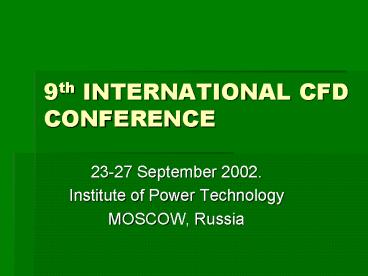9th INTERNATIONAL CFD CONFERENCE - PowerPoint PPT Presentation
1 / 19
Title:
9th INTERNATIONAL CFD CONFERENCE
Description:
... much larger, up to four times than the windward side of the down wind building. ... near the upwind buildings and downdrafts near the downwind buildings. ... – PowerPoint PPT presentation
Number of Views:124
Avg rating:3.0/5.0
Title: 9th INTERNATIONAL CFD CONFERENCE
1
9th INTERNATIONAL CFD CONFERENCE
- 23-27 September 2002.
- Institute of Power Technology
- MOSCOW, Russia
2
(No Transcript)
3
NUMERICAL PREDICTION OF DISPERSION
CHARACTERISTICS OF AIR POLLUTANTS IN IDEALISED
URBAN STREET CANYONS
- DEJAN MUMOVIC and JOHN M. CROWTHER
4
BACKGROUND
- Part IV of the Environment Act 1995 led to the
Air Quality Strategy for England, Scotland, Wales
and Northern Ireland, (AQS), is revised and
published in January 2000. The Strategy sets
standards and objectives for the main air
pollutants of concern. - Where one or more of the prescribed air quality
objectives is not likely to be met by set dates
between 2004 and 2009, Local Authorities must
declare an Air Quality Management Area (AQMA)
5
According to the latest report on the state of
air quality, Glasgow, as the biggest city in the
Scotland, has areas at risk of exceeding
existing or proposed new air quality objectives.
6
(No Transcript)
7
INTRODUCTION
- The governing equation set is Reynolds-averaged
in Cartesian coordinates and includes the
horizontal momentum equation, the vertical
momentum equation, the mass continuity equation,
and the transport equation for pollutant
concentration.
8
The aim of the present study is to develop a
three-dimensional numerical model based on the
Reynolds averaged Navier-Stokes equations,
coupled with the following turbulence
modelsStandard k-? turbulence modelRNG
turbulence modelChen-Kim k-e turbulence
modelTwo scale turbulence model
9
SETTINGS
- The figure shows the computational street canyon
configuration of Hope Street in Glasgow, for
B/H1, where B is the street canyon width, and is
equal to B 20m H is the building height, and is
determined as H 20m. The length of the street is
L 180 m.
10
RESULTS
- It can be noted that for all cases, a vortex was
formed within the street canyon, characterised by
updrafts near the upwind buildings and downdrafts
near the downwind buildings.
- Both the experimental and calculated results show
that the magnitude of pollutant concentrations on
the leeward side of the up wind building is much
larger, up to four times than the windward side
of the down wind building.
11
Table 1 Time consumed for numerical calculation
under four different turbulence models and two
different grids
Hoursminutes Standard k-e RNG k-e Chen-Kim k-e Two scale
Coarse grid 022 023 024 052
Refined grid 049 051 053 150
12
The figure shows, that on the leeward side, the
pollutant concentrations decrease exponentially
from the street surface to the roof of the up
wind building for all tested turbulence models.
13
The figure shows the horizontal wind velocity at
the leeward face of the upwind building predicted
by the developed model coupled with the four
different turbulence models, and compared with
the experimental data.
14
Dependency of the dispersion of the pollutants on
the aspect ratio for the chosen RNG k-e model is
given in the figure. The air flow characteristics
are compared with previous research findings
(Hassan and Crowther, 1999) and highly
satisfactory agreement is obtained.
15
The set of tests conducted to examine the
influence of grid refinement on the dispersion of
the pollutants shows that working domain is
fairly scaled if 40 to 60 cm is represented by
single cell near pavement.
16
- The sample intake was situated 2.5 m above
pavement and 0.5 m from the kerb. When the wind
was from the east (90º) the sampler was on the
leeward face. - The figure shows the comparison between the
predicted and measured CO concentrations at the
leeward and the windward faces.
17
The reasonable agreement between the calculated
and observed concentrations, proves that
PHOENICS, as a general CFD code, is capable to
predict the pollutant distributions emitted by
vehicle within an urban street canyon.
18
ACKNOWLEDGEMENTS
- D. Mumovic wishes to thank to The Lord Provost of
Glasgow, Mr. Alex Mosson, for a warm welcome and
encouraging discussions. The authors wish to
thank to Mr. Peter Spalding for his overwhelming
help, without whom this study would be impossible.
19
9th INTERNATIONAL CFD CONFERENCE
- 23-27 September 2002.
- Institute of Power Technology
- MOSCOW, Russia

